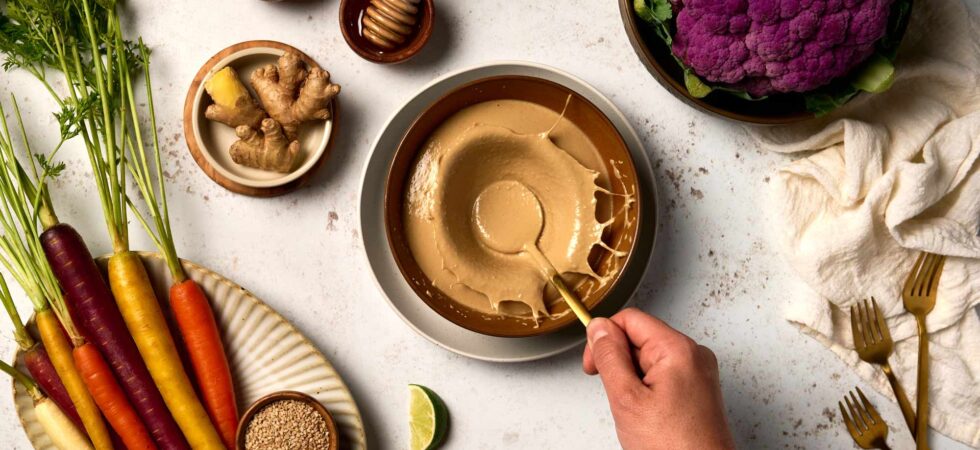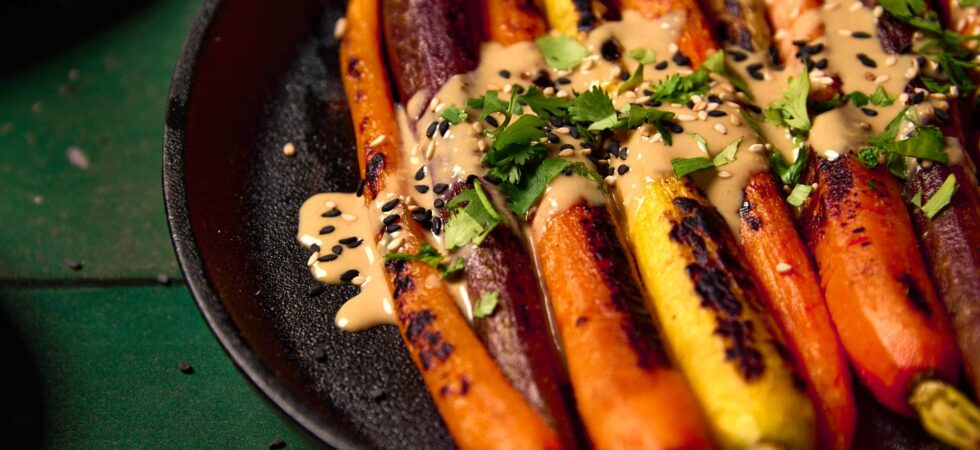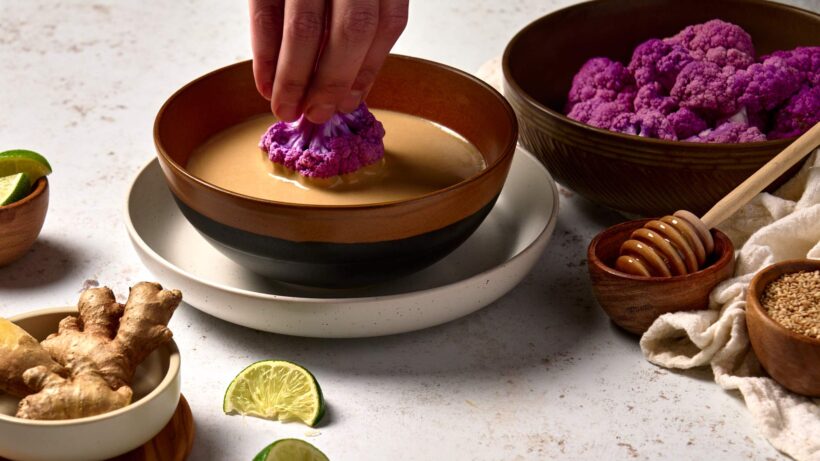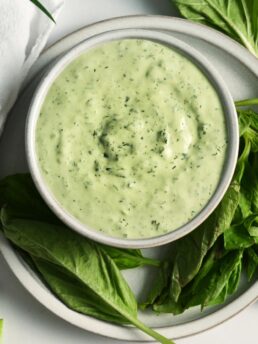Asian-Inspired, Tahini-Ginger Dressing

I used to buy this Tahini-Ginger Dressing in bulk, to-go containers from a sushi place that closed down over a decade ago. For those of you who remember Jasmine’s Cafe near the Florida Capitol, this is a copycat of their house salad dressing (IYKYK).
It’s fresh, aromatic, sweet, and savory all at the same time, and a far cry better than the orange-colored, ginger dressing at most sushi places. I promise you’ll be licking your fingers and eating spoonfuls of this with or without the veggies.
I swear, at this point, 50% of my recipes are me recreating food that I don’t have access to; Be it discontinued, from a restaurant that closed down, or from somewhere too far away for me to frequent. 🙂

Get the Recipe: Tahini-Ginger Dressing
Ingredients
- 1½ tablespoons ginger, fresh grated
- 4 cloves roasted garlic OR 2 cloves fresh garlic, (See FAQ)
- 2 tablespoons white miso paste
- 2 teaspoons tamari , (see FAQ for subs)
- 2 teaspoons lime juice, fresh squeezed
- 2 teaspoons mild rice vinegar
- ½ tablespoon sesame oil
- 4 teaspoons honey, (see FAQ for vegan subs)
- ½ cup tahini
- ⅓-½ cup water
Equipment
- 1 microplane
- 1 small spoon
- Measuring spoons
- measuring Cups
- 1 Whisk or fork
- 1 bowl
- 1 Immersion blender optional
Instructions
- First, use a small spoon to peel the ginger. To do this, scrape along the ginger root’s skin with the edge of the spoon’s bowl. Once the skin has been removed and about a 2x1in (5×2.5cm) section of flesh is exposed, it’s time to grate. Take a microplane or fine grater, and run the ginger up and down quickly, to remove the fresh ginger meat from its fibers.
- When you have enough, add it to your bowl. Then add in the roasted garlic cloves (See FAQ if you don’t have roasted garlic: you can use fresh garlic or follow the instructions to make your own.) and miso paste. Mush the three into a paste and then pour in the tamari, lime juice, and vinegar. Whisk until this becomes a well-incorporated loose paste. At this point you can add the remaining four ingredients.
- Whisk or mix with a fork until you have a uniform dressing. The mixture will seize a bit and then loosen as the water fully incorporates. Start with ¼ cup (60ml) of water. Then mix in more until it’s a consistency you like.
- That’s it! Dip and drizzle to your heart’s content!
Notes
- Store the dressing in a sealed container, in the refrigerator, for up to 2 weeks.
- Making a paste of the more solid ingredients and then loosening them before adding the tahini and water incorporates them better into the dressing. If you use an immersion blender or a blender to incorporate the ingredients even more, you don’t need to add them in a specific order.
- Of Note: making roasted garlic – if you don’t have it already – adds 45min. (the FAQ has the roasting instructions and fresh garlic substitution if you want to save time) I suggest bulk roasting garlic and freezing it for later use. 🙂
- For more substitutions, see the FAQ. There’s a lot of flexibility in this recipe!
- Tasting/Tweaking Notes:
-
- If you like a strong ginger flavor, this is the recipe for you. If you want a more subdued ginger flavor, only use 1tbsp (12g) grated ginger.
- If the dressing feels flat, add ¼tsp of lime juice (1.25ml) or miso paste (1.4g) at a time, until you are happy.
- If it’s too bitter or tart, add more honey/sweetener, also ¼tsp (1.25ml) at a time.
- If it’s too thick, mix in some more water ½tbsp (7.5ml) at a time.
- Like ginger, feel free to measure the garlic with your heart.
Nutrition

Frequently Asked Questions
Tahini is a creamy paste made from ground sesame seeds. It’s flavor is very mild and earthy.
The seeds can either be hulled or un-hulled. With the most common type being hulled. Hulled tahini is lighter in color and less bitter than its un-hulled counterpart.
In your search for tahini, you may also find raw or roasted tahini. Dark roasted tahini is the most intense tahini, with smoky flavor and a deeper color than raw tahini. Most containers of tahini paste from the store are un-roasted or lightly roasted.
Choose ginger that looks firm, plump, and smooth. The skin of fresh ginger should be thin and glossy, not dry or flaky.
Much like with melons and citrus, pick up the ginger root and feel its weight. It should feel heavy for its size, indicating that it’s filled with moisture.
I know the “fingers” or “knobs” on the ginger root feel like something to avoid, however, these are the parts from which new growth emerges. If the tips of the fingers are smooth, they are actually a good indicator of the ginger’s freshness.
Obvious, I know, but this is the internet… Avoid ginger that is wrinkled, shriveled, or has soft spots.
Yes. Please consider following these the next time you buy some ginger, if you aren’t already doing so.
I know breaking off extra fingers for a smaller amount of ginger or less knobbed pieces in general can be “ap-peel-ing”, for easier peeling (See what I did there?) and for your wallet, but this practice makes it harder for stores to keep the ginger fresh for other shoppers.
The damage caused when breaking off pieces leaves the fresh ginger open to the elements and these ends dry out fairly quickly. It’s kind of like cutting an apple in half and leaving the rest in the stand for other people to purchase. Be kind. Don’t break it, just buy it.
If you are worried about all the knobs and peeling around them, (I get it, these little guys can be time consuming) make things easier on yourself and simply slice the smaller knobs to use them in teas and infused syrups. Then you’re free to peel the easier parts and grate the rest.
Pro Tip: Ginger freezes really well, so bulk prepping is a fantastic option. After slicing the difficult pieces, peel and toss the other pieces into a blender with a little bit of water. Then freeze the resulting ginger puree into 1tsp (5ml) pucks for later use. It’s great for sauces, marinades, fillings and more! I, myself, freeze sliced ginger for a month or so at a time before I start to notice some of the potency diminish.
Tamari is a Japanese sauce made from fermented soybeans (miso), water, salt, and koji (fermented rice). As such, it’s typically produced with little to no wheat. This makes it a good option for people with gluten sensitivity.
Tamari has a slightly thicker consistency compared to regular soy sauce. It’s often described as having a smoother, rounder, and more robust taste with less saltiness.
If you don’t have tamari, no sweat. Use dark soy sauce or regular soy sauce in its place. Because (Japanese) tamari and (Chinese) soy sauce are both made from fermented soybeans, they have very similar flavor profile.
For dark soy sauce use a 1:1 substitution. For regular soy sauce, start with 3/4 of the listed tamari and then add to taste. Regular soy sauce is lighter and more salty due to its wheat content.
For a vegan version of this dressing, swap the honey for the same amount of either maple syrup or agave. (maple syrup is sweeter, so start with 2 tsp (10ml) and then add more to taste.
For the 4 cloves of roasted garlic, preheat your oven to 400°F (204°C) cut the top of garlic bulb so the tops of each clove have been sliced off. Then place the bulb into the middle of a piece of aluminum foil, drizzle about 1tbsp (12ml) of olive oil over the top, and wrap up the whole thing so it won’t leak. Bake for 30-40 minutes. Take the garlic out of the oven and let it rest and steam on the counter for another 5-10 minutes. Then, unwrap the bulb and either use the tines of a fork to pull the cloves free or squeeze all of the cloves out at once.
1 tsp (5g) of garlic paste is the equivalent of 2 cloves of garlic. Simply scale up and save the rest for other recipes. 🙂
Yep! If you don’t have roasted garlic or don’t want to make it, you can definitely use fresh garlic. Swap the roasted garlic for 2 cloves of fresh garlic. Make sure to fine mince them. Then smush them into a paste by running the edge of your knife back and forth over the minced pile.



